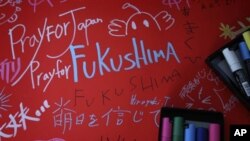Strong aftershocks continued to rock northeastern Japan, while firefighters and repair personnel risked excessive radiation exposure at a heavily damaged nuclear-power plant.
At the same time, elevated levels of radioactive materials in sea water off Fukushima are raising concerns that Japan's important fishing industry will be hit with an even deeper blow. Many fishing communities were destroyed or severely damaged by the March 11th tsunami triggered by a magnitude 9.0 earthquake.
The government ordered expanded testing of marine life and sea water to begin Wednesday.
Traces of external radiation from the damaged Fukushima-1 nuclear plant have already tainted raw milk and spinach, as well as tap water. Government officials and scientists say the levels, while significantly above normal, do not pose a threat to human health even if the contaminated food and liquids are ingested for a year.
Concerns also continued for a second consecutive day about the significance of steam emanating from one of the damaged reactors and smoke from another reactor building. But government officials say the emissions do not appear to be a serious hazard, giving them cause to express some optimism the worst may be over.
The possibility of the used fuel rods reaching a highly dangerous critical state again is extremely low, says Nuclear and Industrial Safety Agency Deputy Director Hidehiko Nishiyama.
He adds, although the core fuel in some reactors may have partially melted, there is no anticipation of a total meltdown.
For the sixth day, firefighters sprayed water on the reactors and pools containing the used fuel rods. Keeping the fuel elements from getting overheated will further decrease radiation.
The prime minister's deputy spokesman Noriyuki Shikata says lowering the radiation levels will allow the most important missions to go faster.
"As the situation becomes stabilized, we have room for more workers coming back to the site in order to engage in, for example, possible power connectivities and to engage in the cooling of the reactors,' says Shikata.
Tokyo Electric Power Company, which runs the plant, says electrical lines have been restored to all six reactors and power will be switched on to re-circulate water after further inspections. That would be a major step towards automating cooling by completely submerging the exposed spent fuel.
The cooling system was severely damaged by the March 11 tsunami.
Japan's police agency says the number of those who were killed or are still missing as a result of the earthquake or the resulting tsunami has surpassed 22,000. Up to a half a million people have been displaced because their homes were destroyed or damaged, or they were ordered to leave communities near the crippled nuclear power plant.













